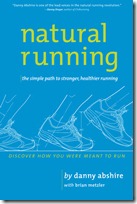 I’ve recently begun to notice a change in how people are defining the minimalist running movement. No longer is it just about the shoes (or barefooting for that matter) – rather, people are beginning to emphasize that although minimalist shoes and barefoot running are important, their true value lies in the fact that they can act as tools to help you achieve better running form. Even barefoot proponent and “Born to Run” author Christopher McDougall is pushing the “form-first” mantra, as evidenced by the following quote from an interview with Bill Katovsky on the Zero Drop Blog:
I’ve recently begun to notice a change in how people are defining the minimalist running movement. No longer is it just about the shoes (or barefooting for that matter) – rather, people are beginning to emphasize that although minimalist shoes and barefoot running are important, their true value lies in the fact that they can act as tools to help you achieve better running form. Even barefoot proponent and “Born to Run” author Christopher McDougall is pushing the “form-first” mantra, as evidenced by the following quote from an interview with Bill Katovsky on the Zero Drop Blog:
“I’m more interested in the future of running form. I couldn’t care less what people wear; I’m more concerned about what they do. For too long, all we’ve heard about is what to buy; what’s been missing from the conversation has been how to run properly. I’m convinced that the next big wave in running won’t be footwear, but a surge in running coaches who teach proper, gentle, barefoot-style form.”
Update 12/13/10: Christopher McDougall emailed me and wanted to emphasize that he has been pushing “form-first” since day one. Here’s a quote from a post on the barefoot running debate from his blog:
“…the secret to injury-free running isn’t the proper shoe. It isn’t stretching. It isn’t even training mileage. It’s skill. Like every other sport, healthy running is all about technique. But why hadn’t I ever heard that before? All I ever heard, over and over, was about shoes. Every podiatrist, sports physician, and running magazine preached endlessly about the absolute necessity of corrective footwear. I was never told what to do; I was only told what to buy.”
The thinking is that barefoot-style running form will allow you to run more efficiently and with less likelihood of sustaining a dreaded overuse injury. If there’s one thing that runners fear above all else, it’s an injury that prevents them from logging miles out on the road and trail. While the verdict is still out on whether all runners might benefit from changing form, my anecdotal experience in the form of receiving emails from readers is that changing running form has the power to allow at least some subset of formerly hobbled runners to run injury free – of this I am now 100% convinced. My own form change experiment has been both fun and fascinating, and is still a work in progress (probably always will be), so I was excited and curious when I was contacted by Backbone Media and Velo Press about reviewing Danny Abshire’s new book called Natural Running (written with Brian Metzler of Running Times Magazine).
If you don’t know Danny Abshire, he’s one of the cofounders of Newton Running, makers of the popular and pricey Newton brand of running shoes. Newton is unique in that their mission from the start (they were founded in 2007) was to produce shoes that fostered a natural running style. Abshire also has long history as a maker of custom orthotics, and he tells this story in the book – he’s a big proponent of proper forefoot balance and believes that orthotic intervention is warranted in some cases to achieve this balance. I personally don’t have much problem with this in some cases, but the question remains whether some types of forefoot imbalances are a product of our shoe-wearing history and whether wearing more minimal shoes can help correct imbalances by allowing the foot to strengthen and work more naturally – the verdict is still out. Hardcore minimalists and many barefoot runners might argue that orthotic intervention is anything but “natural,” though I prefer to not be dogmatic on issues like this where solid evidence is still lacking. This, however, is a discussion for another day.
In a nutshell, Natural Running is described by Abshire as a style that mimics what we do when barefoot: light landing on the midfoot/forefoot, slight forward lean of the torso, and a landing underneath the center of gravity (the hips). In his book, Abshire discusses the problems with modern shoes, the basic biomechanics of the running gait, and provides helpful tips on how to assess your own form and pick out any potential problem spots with your feet. The recurring phrase that he use repeatedly throughout the book is that a runner needs to “stay in balance with gravity.” He views proper balance as being of utmost importance, and deviations from proper balance can set up a chain reaction of negative events through our joints, particularly if we pound the pavement with our heels as we run. I found this discussion interesting and informative, and Abshire’s writing style is one of the patient and fatherly coach who simply wants you to be able to run better.
The last several chapters of Natural Running lay out a series of strengthening exercises and form drills designed to help you make a smooth transition to natural running. These are detailed, but like so many of the workout guides found in popular magazines like Runner’s World, I wonder how many people will take the time to follow them. I’m more of a jump in and (carefully) try it kind of guy, and this technique seems to have worked well for me. That being said, if you are looking for detailed information, this book is an excellent choice in most respects.
I only had a few points of disagreement with what Abshire has to say in Natural Running. First, he repeats the oft used mantra to “land directly under your center of gravity (hips).” For example, here’s a direct quote:
“Put simply, have your feet contact the ground beneath your center of mass. From there, you’ll be set up for efficient whole body kinematics. If your foot strikes are slightly in front of your body mass, you’re braking and will need to add power to keep moving forward.”
As I outlined in a long and detailed post on where footstrike should occur, I don’t believe that it is physically possible to land directly under your center of mass. Steve Magness of the Science of Running blog agrees, and wrote a long post himself explaining why. It may be a minor point, but it’s repeated numerous times in the book, and I have yet to see anybody actually doing it. A more accurate way to phrase things would be to land slightly in front of the hips, and allow maximum loading to occur when the foot is under the center of mass. Alternatively, it can be effective to suggest landing under the center of mass as a cue, with the understanding that it doesn’t really happen in practice.
Another point of question is when Abshire states the following:
“The process of sensory communication from your feet is at its best when you are barefoot. That sensory interaction still happens if you’re wearing shoes, but it works a heck of a lot better if you can feel the ground through your shoes. If your foot is raised high off the ground, as is the case with many traditional running shoes with foamy midsoles, the sensory input is dampened considerably.”
I agree with the above statement, but it’s a bit odd considering that Newton shoes generally have a very thick midsole that sits the foot high above the ground (see photo below). Granted, the midsole is firm and provides better sensory input than a soft slab of EVA, but combined with the odd sensation of the forefoot lugs, it’s still far from being barefoot-like. Don’t get me wrong, I’m enjoying running in a nearly zero-drop pair of Newton Distance Racers right now, and they do allow easily for a midfoot stride (see video below), I just don’t think they provide the ground feel suggested by the above quote (certainly nowhere close to a shoe like the Vibrams, or even a low-profile road flat). Again, a small point, but one that needed to be mentioned.
Newton Distance Racer – note the thick midsole
On the plus side, my friend Brandon of the Brandon’s Marathon Podcast recently posted a photo of a lower profile and apparently zero-drop racing flat that Newton has in development (see photo below) – the zero drop march continues to move forward!
Newton Zero Drop Racing Flat???
Conclusion
All-in-all, Abshire’s Natural Running was a great read (I read it in 3 days!) and I would highly recommend it as a guide if you are looking to transition to barefoot-style running form and want to keep your shoes. Abshire is very scientific and sensible in his approach, and despite my few small points of disagreement, I found most of the information to be high quality and very useful. He clearly know his way around the human foot, and I anticipate that this book will find it’s place alongside others which are attempting to change the way we run. I don’t believe that there is such a thing as a perfect form that equally applies to every person, so it’s up to the reader to try out Abshire’s approach to see if it works for them. As Abshire states, we are in the midst of a running re-evolution, and if you desire to get off your heels, Natural Running is a resource that will help you get back to running naturally like you did when you were a kid.
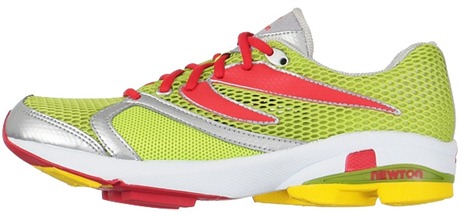
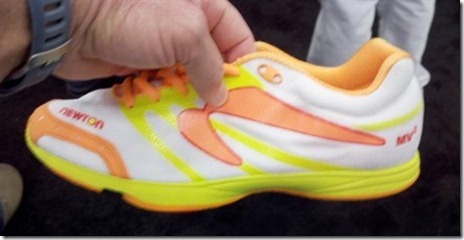
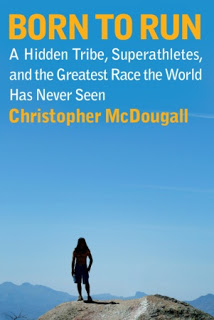
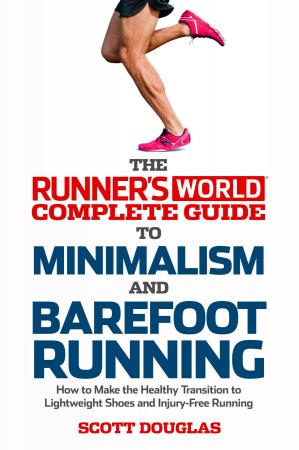
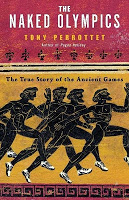
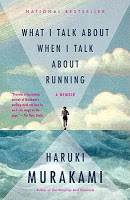
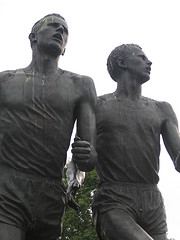














My one complaint against Newton is the color of their shoes. Why does Newton make some of the most ugly running shoes known? There new prototype trail shoe is nothing but a collage of neon.
I took that photo of the NEW Newton Racing Flat in Austin. I met Danny there along with the rest of the Newton Running Crew. I completely agree with this.
Cool – thanks for sharing it. Have you tried out the shoe?
Pete
Sounds like an interesting book. I have been a Newton fan for about a year now. Just bought a pair of the neutral Newton racing shoe. My son (perfect forefoot runner) loves them as well. I agree on the comment on color though I think I like the racing shoe color.
No I didn’t try it but “touched” it at the show. Seems like it will be another great shoe from Newton. I am now a dealer so I might lean that way………….Thank you for the GREAT blogs…you have helped me and others.
http://www.islandstridesports.com
I held the shoe but didn’t try it on the show floor. Amazingly lightweight.
Looks interesting for sure. Does it have the lugs? Not sure how those
would feel in a flat.
Pete
On Wednesday, January 5, 2011, Disqus
Why did “form” even disappear from the conversation? I remember form — in particular avoiding heel strike as a method to avoid injury — as being in the running community discourse in the mid-80s. What happened over the next 25 years? The no-holds-barred era of shoe technologies? If so, isn’t that a sad commentary on the integrity of running journalism? At the minimum it implies that the popular running magazines are beholden to their advertisers.
It didn’t. A quick reading of RW and RT going back the last 15-20 years has plenty of articles/ advice on form. I know- I have those mags.
It’s blogger’s like this who focus so much on foot strike that we think only in those terms. The term ‘Barefoot running” only concerns itself with the foot.
And the next big thing “Heel to toe” drop is the same darn thing.
I remember an article in Runner’s World around ’93-’95 on the Tarahumara Indians of Mexico. Seems funny that the barefoot and minimalist running movement didn’t come out of that round of press.
That’s cause no one figured out how to make money off it yet.
Pete, seems like an interesting book, although I fully agree with your points of disagreement. In terms of natural running, I have now a calf pain due to lack of strenghtening this muscle. Apparently you didn’t have any major problem in the transition but, in my case, I had foot pain and now this calf pain. Anyway, these are normal according to other cases I have been reading and the benefits of midfoot striking are by far greater than the costs associated with the transition.
Regards,
Sergio (Brazil)
corredorfeliz.blogspot.com
This looks like a book I’ll want to read some time soon.
My form journey is also one of injury avoidance. I had surgery on my left foot to correct Frieberg’s Infraction, and was feeling the same symptoms in my right. I knew I needed to change something, or the almost 3-year journey back to running from that surgery would be repeated. I’ve found that not only is my foot landing a big issue, but also the toe-off phase.
And to add one other complaint about Newtons… The price! In fact, one issue I continually rail against is the price point that all the new “minimalist” shoes are coming in at — $100 plus. Tell me why a shoe is being introduced with LESS material, but is priced higher? On the Born to Run forum, the pat answer is always “why don’t you make your own for less and sell them?” Well, wouldn’t the point be that these large companies, who can get the materials at a far lower price than I ever could (volume), be able to make them for far less? The bottom line is that they sell the shoes for the price they do because people will continue to pay it…
Okay, off my soap box now…
I agree totally on the price issue. The shoe folks smell a popular trend,
and are doing the best they can to capitalize. I applaud New Balance for
it’s pricing on a shoe like the MT101 – just picked up a pair for $55 at
Running Warehouse. I don’t think the Minimus line will follow suit though.
Pete
In response to Bpearce1:
Absolutely. And not just the running magazines. It’s the same thing in the cycling mags, the motorcycle mags… All of them. In fact, here’s a little experiment — every time you see a review, take a look 2 pages before and after that article. Chances are you’ll see an ad for that very product within those pages. Magazine reviews are rarely more than a regurgitation of press releases, and even more rarely talk negatively about the product.
Sadly, we’re all guilty of it to a degree. I advertise for Running Warehouse
and use Google ads because I need to justify the time I put into this blog.
That being said, one can still be honest and do advertising. I find that
some companies want to hear about flaws in their products so that they can
correct them. My bigger problem with most mass media reviews is that they
are usually superficial and uninformative, which makes one think even more
that they are just advertising pieces. I go to blogs for reviews (Running
and Rambling, iRunFar, and the like) because you know the reviewers and can
interact with them and ask questions. We all advertise, but we try to be
honest.
Pete
Pete, you mentioned this briefly, but I think by telling runners to land “directly underneath” their center of mass, it’s helping to reinforce where runners should land. It won’t happen exactly under the center of mass, but as a coaching tool it’s valuable so people “get it.”
Do you think the strengthening exercises he lays out at the end are good or just the same old stuff? I’m undecided whether to pick up a copy…
Jason,
I agree – it’s a good cue, but it’s not reality. It’s a pet peeve of mine
when people say that we should do it without ever acknowledging that it
doesn’t happen in reality. It’s not good biomechanics.
As for the strengthening, I didn’t read them in depth, but I don’t think
there’s much there that will be new to you. If you do pick the book up, I’d
love to hear what you think.
Pete
Seems to me that if we’re moving forward, our center of gravity isn’t in the same place as when we’re standing. If my feet suddenly stop while I’m running I’m no longer balanced (I know this for a fact).
Gravity is a vertical force, so horizontal motion doesn’t change it. COG is
the average location of the weight of an object, which in humans is around
the hips, and gravity works to drive the center mass of the body into the
ground. When talking about landing under the COG, you will also see “land
directly under your hips” used interchangeably. This does not happen in
practice. I’m no physicist, but I think you are thinking about momentum.
Pete
As far as the Newton shoes go, it seems counter-intuitive to add so much material and technology while claiming to be more natural running shoes. I thought that people tended to strike the ground harder so that they actually feel it when there is more material between them and the ground. Anyhow, I haven’t run in them so I could be way off. They just seem like they take the idea of natural running and then apply the same misguided technological “solutions” that have plagued the running industry so far.
I think it’s not so much that the foot strikes harder just because there’s material there. More that it striked harder when there’s something cushioned under it.
Pete – I haven’t checked this book out yet, but my own personal experience working on my running form was greatly aided by Matt Fitzgerald’s “Brain Training for Runners.” Great book, with a lot of helpful drills to get you away from heel striking. Also, the author is a coach and athlete, not the affiliate of a shoe company.
Eric
Pete – Good review of Abshire’s new book. I haven’t read it, but plan to pick up a copy in the near future.
One thought on your “point of question” with Abshire’s quote on “The process of sensory communication.” Though I agree with you that Newton shoes do not give you a feel for the ground (like barefoot running) and can see how Abshire’s statement struck you as odd (maybe even contradictory) – however, I think he is just being honest.
To clarify – Abshire could have used his book to push his product (which maybe he is in other parts of the book – again, I haven’t read it yet), but based on the snip-it you quoted, it sounds like he is taking his “Newton hat” off and giving the reader unbiased information to consider.
Again, good book review and the Christmas card picture of your shoes is pretty cool. I think just about every major brand of footwear it represented.
Signed,
A fellow shoe addict who has given up on recovery.
Could very well be – I will give Abshire credit as the book definitely did
not come off as a “you must buy Newton’s” kind of book. He was very even in
his discussion and the book was very informative.
Pete
Pete and Puff-Daddy, Danny was careful to make sure the book is useful for runners using any brand of shoe. We consider Natural Running to be somewhat of a technique user guide for shoes. Newton is mentioned in the history of shoe tech section and once or twice later, but the goal of the book is broad: learn how to run with healthy technique while wearing shoes. Dave Trendler, VeloPress
Dave and Pete – I got the book just over a week ago, and like Pete, I finished it in 3 days. There is some really good information to consider and how to apply it to my own running. For years I have been trying to improve my own form for better running economy – but there was one point that hit home which I am starting to incorporate…
In an attempt to stop over-striding, years ago I started to play with my form and land more on the forefront/balls of my feet. It took time to adapt, but after 3-4 months it became natural and my times improved. However, I was bouncing more with each stride and didn’t know how to correct this. I didn’t consider that I could still be over-striding by landing on the front of my feet and this was the cause of my bouncing. BTW – my daughter (who runs with me on occasion) is the one who pointed out my bouncing stride.
The thing I’m focused on to correct this is – glancing down occasionally to see if I can see my foot. If I can, I know I’m reaching out too far and need to shorten my stride.
The other thing I’m working on is letting my heal settle to the ground before it goes into the lever phase.
My goals in incorporating these changes are to (a) reduce occurrences of injuries, (b) improve running economy and (c) see if there are things I want to incorporate into the training of the athletes I coach.
I’ll see how things go for me over the next few months and maybe post an update with my progress. But so far, I do feel a little more relaxed when I run and am little less fatigued when done.
My only comment/suggestion is that the book be release in an e-reader format. Hopefully this is in the works.
Puff-Daddy